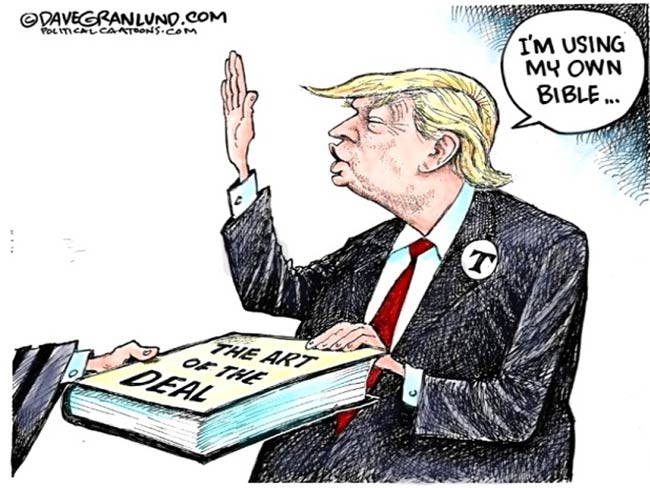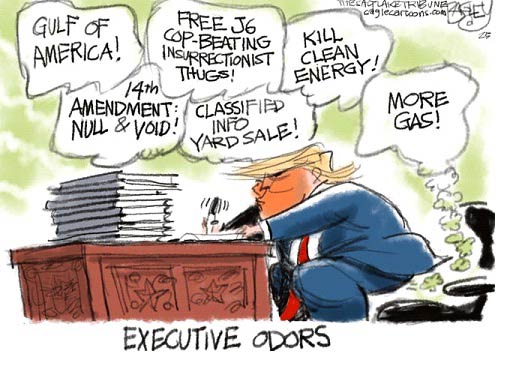Features
Trump’s Second Coming and the Tech-Industry Complex

by Rajan Philips
Turning and turning in the widening gyre
The falcon cannot hear the falconer;
Things fall apart; the centre cannot hold;
Mere anarchy is loosed upon the world,
The blood-dimmed tide is loosed, and everywhere
The ceremony of innocence is drowned;
The best lack all conviction, while the worst
Are full of passionate intensity.· W.B. Yeats, The Second Coming
It is pathos time in American politics. In his second inaugural address on Monday, January 20, Donald Trump proclaimed divine causality for his second coming. “My life was saved for a reason. I was saved by God to make America great again,” declared Trump. He was referring to the failed attempts on his life during the election campaign.
But there was no hint of humility or any offering of thanks for God’s mercy. Neither attribute is a part of his constitution, and Trump owes nothing to the god he has created for himself to be used as a marketing embellishment. While there is nothing eschatological about Trump’s second coming, what rings familiar is Yeats’s second coming foreboding from a different era a hundred years ago. The Irish poet’s insight forcefully captures Trump’s America – where the best lack conviction and the worst have all the intensity.
An even more powerful insight as well as foresight of what is now unfolding in America can be found in the writings of the progressive American philosopher Richard Rorty (1931-2007) from the late 1990s. Rorty’s 1998 book, Achieving Our Country: Leftist Thought in Twentieth-Century America, has been noted for its prophetic prediction of “an authoritarian strongman” rising to power taking advantage of the economical struggles of the working classes and their disaffection with over-righteous left-liberals preaching social rights over economic necessities. Trump’s election in 2016 fulfilled Rorty’s 1998 prophesy.
The Dark Years and Beyond
Two years earlier in 1996, Rorty presaged Trump’s second coming in a retro-futuristic essay entitled, “Looking Backwards from the Year 2096.” The essay is presented as an excerpt from a speculative article on ‘Fraternity’ published in a 2095 symposium edited by symbolically fictional Cynthia Rodriguez, SJ and Youzheng (not Kash) Patel, and offers these glimpses of light at the end of a long Trumpian tunnel:
“Our long, hesitant, painful recovery, over the last five decades, from the breakdown of democratic institutions during the Dark Years (2014-2044) has changed our political vocabulary, as well as our sense of the relation between the moral order and the economic order. Just as twentieth-century Americans had trouble imagining how their pre-Civil War ancestors could have stomached slavery, so we at the end of the twenty-first century have trouble imagining how our great-grandparents could have legally permitted a CEO to get 20 times more than her lowest paid employees. We cannot understand how Americans a hundred years ago could have tolerated the horrific contrast between a childhood spent in the suburbs and one spent in the ghettos. Such inequalities seem to us evident moral abominations, but the vast majority of our ancestors took them to be regrettable necessities.”
Rorty died one year before Obama was elected, but he was spot on in setting the start of the Dark Years that began with Trump’s foray into politics to negate the promises of Obama’s presidency. But Trump was not a one-term aberration as many thought he would be, and Biden’s presidency did not turn out to be a permanent restoration after Trump. Indeed, another American prognosticator, Harvard University’s Michael Sandel, has called the Biden presidency an interregnum between Trump’s two terms. Trump is now musing about a third term and there is no limit to what he thinks he can do. He might even fancy that he is physically immortal. But there are limits to what he can actually do and even to the lasting effects of all his executive orders and odours that he has been issuing in the first two weeks of his second term.
In Rorty’s sweep of American history, Americans overcame the scourge of slavery in their first hundred years, and they opened the age of human rights and social rights for all peoples in the next hundred years. The Dark Years under Trump are the culmination of the tussles between the promises of the welfare state and supremacy of the market; the frustrations of socialist endeavours followed by the fanaticism of globalization; the fragmentation of societies and lopsided wealth distribution between the overclass of the super-rich and the professional and cultural elites, on the one hand, and the mass of underclasses, on the other; and the rise of populisms targeting the very structures that were created to expand equality and inclusivity as deep state enemies of the people.
Rorty is optimistic that by 2044, twenty first-century Americans, like their predecessors in the earlier two centuries, will find their enlightened way out of the current darkness by rediscovering fraternity and unselfishness and moving past the insistence over rights and their denial. Fraternity, for Rorty, “is an inclination of the heart,” and “not the sort of thing that anybody can have a theory about or that people can be argued into having.” The sources for this metamorphosis will come not from philosophers, lawyers, political theorists or social scientists, but from a “political discourse dominated by quotations from Scripture and literature” that have always been a huge part of the American spirit and ethos. From the likes of John Steinbeck’s “Grapes of Wrath,” and the “social gospel theology” of Walter Rauschenbusch.
If Rorty’s end goals seem utopian, the means to them that he advocates are not. Nor are they ahistorical. The means involve reconstituting the old “coalition of trade unions and churches” that would “topple(d) the military dictatorship in 2044” and “retain(ed) control of Congress by successfully convincing the voters that its opponents constitute ‘the parties of selfishness’.” While Rorty’s prescience is remarkable, even though there is no military dictatorship, it could not be expected to be microscopic about the specific aspects of the current darkness and the way out of it.
For instance, Rorty could not have presaged in any detail the personification of the American crisis in a president called Donald Trump. What might be worrisome for the here and now is whether Trumpism and its hangover could last as far as 2044. To borrow from Scripture, Trump is turning what was set up to be “government of the people, by the people, for the people”, into a “den of thieves,” by the super-rich, for the super-rich. His MAGA (Make America Great Again) universe has always been enthralled by what was mistakenly magnified to be Trump’s business talent and acumen. The truth of the matter is that Trump always knew that he never belonged in the club of the great captains of American capitalism. Now he is pursuing the illusion of presidential greatness.
He seems to be proving to be far more successful in politics than he has been in business. His business was primarily limited to the parking lots and vacant parcels of capitalism, i.e., property development. And he thrived not by playing straight but going crooked all the time. He is deploying the same methods in politics to good, rather bad, effect. He has overshadowed four living former presidents (Clinton, Bush, Obama and Biden), and has bested the two best female candidates who challenged him – Hillary Clinton and Kamala Harris.
A slight majority of American voters ignored and rejected Kamala Harris’s warnings that Trump was carrying an Enemies List, and that his second term would be dedicated to implementing Project 2025 – a conservative road map for using the Trump presidency to overhaul the federal government structures and dismantle the social welfare and civil rights scaffoldings that have been put in place by Franklin Roosevelt’s New Deal and Lyndon Johnson’s Great Society initiatives. Trump is now fully bought into upending them, and is blindly signing Executive Orders drafted by his policy minions.
True to form, the orders are creating chaos and confusion all around, and the executive order to end the funding of federal agencies and programs, all of which have been created by law, had to be rescinded within 24 hours in the face of court challenges and stay orders. The method in all the madness of the Trump presidency is keeping the MAGA base happy and looking after Trump’s super-rich sponsors.
To keep his base happy, Trump has pardoned all 1,500 or so criminals who were already jailed or facing prosecution for the 2021 January 6 insurrection at the Capitol to overturn the results of the 2020 presidential election. That has not gone down well with police organizations, courts and a majority of the population including Republicans. Trump has also fired all the lawyers in the Department of Justice (DOJ) who were involved in indicting Trump for inciting the January 6 insurrection. That should send an unflattering message to Chief Justice Roberts who has defined presidential interactions with the DOJ as a core executive function protected by absolute immunity.
The deportation of illegal immigrants was already a common practice under the Obama and Biden Administrations. But Trump is making a show of it by televising the rounding up and handcuffing of immigrants and deporting them on military aircrafts as opposed to commercial airlines.
A third sop to the base is Trump’s threat to eradicate the policy and programmes implemented by the federal government to promote diversity, equity and inclusion (DEI) in the hiring of government employees and contractors. Their origin goes all the way back to President Kennedy’s 1961 Executive Order that started the American Affirmative Action. Now Trump wants to end it and there is no level too low that he will not stoop to end DEI. He has been doing just that in the wake of the tragic midair crash last Wednesday of a passenger plane and a military helicopter over the Potomac River in Washington.
Rather than showing presidential compassion and empathy over the death of everyone in the two ill-fated aircraft, 67 in all, Trump has taken to blaming Obama, Biden, and Biden’s Transportation Secretary Pete Buttigieg (one of Biden’s more brilliant cabinet ministers) and their DEI hiring practices for the crash. Even Republican politicians are disgusted at the crude crassness of Trump’s politics.
The Tech-Industrial Complex
In his farewell address to the nation on January 15, outgoing President Biden warned of the danger of a “tech-industrial complex” in the form of “an oligarchy (is) taking shape in America of extreme wealth, power and influence that literally threatens our entire democracy, our basic rights and freedoms, and a fair shot for everyone to get ahead.” Biden was following the example of President Eisenhower who had similarly, in his farewell address in 1960, warned of the danger of a military-industrial complex. More than hundred years earlier Theodore Roosevelt had warned of the danger of money power in American politics.
These presidential warnings betray the tensions between the power of capital and the political power of the state. While there is no illusion about the sway that money power and corporate elites have had over any and all governments, never before has an American president surrounded himself with all the richest men the way Trump is doing now. There seems to be no billionaire woman yet who is a member of Trump’s White House billionaire club. What is also unique about this club is that it is comprised entirely of big tech billionaires.
 They are a different breed and are the exponents of what the Greek economist Yanis Varoufakis calls ‘Techno Feudalism.’ One that has been devouring industrial capitalism of old and replacing its two pillars of markets and profits with ‘digital trading platforms’ and ‘cloud rents.’ More on that for another time. The brazenness of this cabal and its agenda run diametrically counter to the nativist compulsions of MAGA populists. Not to mention the internal contradictions and egotistical clashes within the cabal itself.
They are a different breed and are the exponents of what the Greek economist Yanis Varoufakis calls ‘Techno Feudalism.’ One that has been devouring industrial capitalism of old and replacing its two pillars of markets and profits with ‘digital trading platforms’ and ‘cloud rents.’ More on that for another time. The brazenness of this cabal and its agenda run diametrically counter to the nativist compulsions of MAGA populists. Not to mention the internal contradictions and egotistical clashes within the cabal itself.
The chasm between the tech cabal and the rest of the country couldn’t be deeper or wider. In this century so far, the top 1% of Americans, or 3 million people, own more than a third of the national wealth, and tech cabal is at the apex within this group. For the bottom 50% of Americans, or 150 million people, their share of the national wealth is only 1.5%. For the American households, the median household net worth is about $193,000 and median annual household income is about $81,000. It is their cost of living and affordability challenges that Trump exploited to win the presidential election. But after taking his oath as president, and amidst two weeks of non-stop issuance of executive orders, he has said little or nothing about the people’s main grievances that he got elected to address.
At the same time, Trump is pushing his party in Congress to give him the budget to jumpstart his tax reduction agenda amounting to $4 trillion. He needs it to keep his bargain with his billionaire club. But the Republican Party with slender majorities in the Congress and the Senate is not offering Trump its unanimous support without which nothing could be passed by Congress.
For this reason, Trump is looking for alternative revenue sources to accommodate his tax cuts. They include imposing tariffs on imports that has global implications, freeze on federal grants and programs, revenue from increased fossil fuel production and downsizing government. But none of them can be easily implemented or achieved. The cuts to programs to enable tax cuts for the wealthy will impact everyone who is not wealthy and will mobilize their opposition. Democrats are gearing up for the fight, calling Trump’s tax cut agenda – “a contract against America.” The midterm elections in 2026 will show which way the political wind is blowing

